Operational Performance Characterization of a Heat Pump System Utilizing Recycled Water as Heat Sink and Heat Source in a Cool and Dry Climate
Abstract
:1. Introduction
- Use a heat exchanger to recover heat from the warm wastewater exiting a building to pre-heat the incoming cold water [2], or ventilation air.
- Use a water source heat pump to recover heat from the treated wastewater and provide space heating (and/or to dump the heat removed from a building to the wastewater during space cooling operation). This approach is relatively simpler to implement, but it is limited to locations with easy access to treated waste water (e.g., at the outskirts of a city and usually away from the population centers) [3,4,5,6,7,8]
- Use a water source heat pump to recover heat from a network of untreated raw sewage water. This approach often can be implemented at or near the thermal load, but unfortunately, since the raw sewage water contains a large amount of impurity and suspended particles that tend to foul the heat exchanger surfaces and reduce its performance over time, special equipment, and operations are needed to reduce fouling, such as periodic cleaning of heat exchangers, enlarged heat exchanger surfaces, and the use of specially-designed filters to remove particles larger than a certain size [9].
2. RWHP System at the Denver Museum of Nature & Science (DMNS)
3. Performance Characterization
3.1. Recycled Water Temperature
3.2. Heat Flow Analysis
3.3. Temperature Control in the Hot Water Loop
3.4. System COP Analysis
- WWHPCOP = Effective COP of the WWHP unit (Unit COP)
- QHL = Heating output from the modular WWHP (kWh)
- QCL = Cooling output from the modular WWHP (kWh)
- WHP1–7 = Power consumption of the modular WWHP (kWh)
- RWHPCOP = Effective COP of the RWHP system (System COP)
- QSP1 = Supplemental heat added to the source water loop by the steam HX (kWh)
- WRWP = Power consumption of recycled water loop pumps (kWh)
- WCT = Power consumption of cooling tower (kWh)
- WSLP = Power consumption of source loop pumps (kWh)
3.5. Energy and Cost Savings Potential
- It is assumed that there is no difference in the power consumption of the source loop pumps, CHW loop pumps, and HW loop pumps between the baseline and the RWHP systems.
- The water-cooled chiller has a nominal cooling COP of 5.54. A generic performance curve for water-cooled chillers was adopted from the DOE-2 program [14], and used to calculate the chiller power consumption for providing the same hourly cooling output as the RWHP system (including outputs from both the precooling and CHW loops).
- The natural gas fired boiler has a thermal efficiency of 80% and provides the same hourly heating outputs as both the WWHPs and the steam HXs in the HW loop.
- The cooling tower power consumption of the baseline system is calculated based on the average heat rejection efficiency of a typical cooling tower, which depends on the average wet-bulb temperature in each month.
- Average utility rates obtained from 2014 and 2015 utility bills were used for energy cost calculations. The average electricity rate is $0.076/kWh and the natural gas rate is $4.84/GJ.
- Derive correlations between the monthly energy use of each major component of the two systems and the monthly average OAT based on available data from January through August in 2015
- Estimate the energy use of the two systems with the derived correlations and the historical OAT data from September through December 2014.
4. Conclusions and Discussion
4.1. Energy Performance and Cost-Effectiveness
- The measured RW temperatures from the demonstration site during the encompassed period show that RW was more favorable than OA for effective operation of the WWHPs. The maximum OAT was about 35 °C during the cooling season, whereas the maximum RW temperature was about 28.4 °C. The lowest RW temperature was about 3.8 °C during the heating season, whereas the lowest OAT was below −12 °C.
- Effective COPs of the WWHPs and of the entire RWHP system, which account for the simultaneous cooling and heating, were calculated based on the measured data. The effective COP of the WWHPs ranged from 4.6 to 6.0, whereas the effective COPs of the RWHP system ranged from 2.6 to 4.4 during the eight-month investigative period of this study. The system COP increased with the increase in OAT, which is in part a result of the increased simultaneous heating and cooling demands for precisely control the humidity and temperature in the building.
- The demonstrated RWHP system saved 4298 GJ of source energy (a 50.0% savings) and $16,295 in energy costs (a 33.8% savings) annually, when compared with a conventional VAV system using a water-cooled chiller and a natural gas–fired boiler, both of which meet the minimum energy efficiencies allowed by ASHRAE 90.1-2013. The energy savings also resulted in 204,980 kg reduction (a 41% reduction) in CO2 emissions.
- The simple payback period of this system is about 58 years. However, if the length of the pipeline for accessing the RW were shortened from 1006 m to 305 m, the cost premium between the RWHP system and the baseline system would have been reduced significantly and thus the simple payback would have been only 11 years.
4.2. Lessons Learned
- The contribution of RW in the studied RWHP system is less than expected. The run-around heat recovery through the precooling loop was very effective and significantly reduced the demand for external heat sources (e.g., the RW and the steam HX). The wet cooling tower rejected more heat than the RW because of the relatively dry air in the Denver area.
- The supplemental heating of the studied RWHP system was oversized. Measured data indicated that the contributions of the steam HXs were very small, and it is likely that the RWHP system could work well without the boiler and the steam HXs, or with just a smaller water heater as a backup. Such a configuration would reduce the complexity and the associated cost of the RWHP system.
- The cost effectiveness of the RWHP system depends on the construction cost of the pipeline for accessing the RW. The RWHP system would have been economically more competitive if the RW were closer to the building.
Acknowledgments
Author Contributions
Conflicts of Interest
Disclaimer
Acronyms
| AHU | air handler unit |
| COP | Coefficient of Performance |
| DHW | domestic hot water |
| DMNS | Denver Museum of Nature & Science |
| GSHP | ground-source heat pump |
| HVAC | heating, ventilation, and air-conditioning |
| HW | hot water |
| HX | heat exchanger |
| LWT | leaving water temperature |
| OA | outdoor air |
| OAT | outdoor air temperature |
| RW | recycled water |
| RWHP | recycled water heat pump |
| TRWS | recycled water supply temperature |
| TSL | source loop temperature |
| VAV | variable air volume |
| VFD | variable frequency drive (VFD) |
| WB | wet bulb |
| WWHP | water-to-water heat pump |
References
- Cipolla, S.; Maglionico, M. Heat recovery from urban wastewater: Analysis of the variability of flow rate and temperature in the sewer of Bologna, Italy. In ATI2013—68th Conference of the Italian Thermal Machines Engineering Association; Elsevier: Amsterdam, The Netherlands, 2014. [Google Scholar]
- DOE (Department of Energy). Heat Recovery from Wastewater Using Gravity-Film Heat Exchanger; Technology Focus, DOE/EE-0247; DOE: Washington, DC, USA, 2001.
- Finns Homes. Finns Use Waste Water to Heat Homes. 2007. Available online: http://www.reuk.co.uk/Finns-Use-Waste-Water-to-Heat-Homes.htm (accessed on 15 January 2018).
- Heat from Sewage to Energize Paris. 2011. Available online: http://www.triplepundit.com/2011/04/heat-sewage-paris-energy/ (accessed on 15 January 2018).
- Lindstorm, H.O. Experiences with a 3.3 MW heat pump using sewage water as heat source. Heat Recover. Syst. 1985, 5, 33–38. [Google Scholar] [CrossRef]
- Energy from Sewage Water—District Heating and District Cooling in Sandvika, with 2 Unitop® 28C Heat Pump Units. 1989. Available online: http://www.friotherm.com/webautor-data/41/katri_vala_e012_uk.pdf (accessed on 15 January 2018).
- Turku Energia. The Wastewater Utilization in Kakola Heat Pump Plant in Finland. 2009. Available online: http://heikaikkitoimii.fi/en/solutions/renewable_energy/services/greenenergycases/tse_turun_seudun_energiantuotanto_oy_kakola_s_heat_pump_station.8.html (accessed on 15 January 2018).
- Zhou, W.; Li, J. Sewage heat source heat pump system’s application examples and prospect analysis in China. In Proceedings of the International Refrigeration and Air-Conditioning Conference, Purdue, West Lafayette, IN, USA, 12–15 July 2004; Paper No. R016. p. 8. [Google Scholar]
- Nova Thermal Energy Brings Geothermal Heat to the Philly Water Department. Available online: http://www.flyingkitemedia.com/innovationnews/novathermaltowaterco1116.aspx (accessed on 15 January 2018).
- Schmid, F. Sewage Water: Interesting Heat Source for Heat Pumps and Chillers; Swiss Energy Agency for Infrastructure Plants: Zurich, Switzerland, 2008; p. 12. [Google Scholar]
- Hepbasli, A.; Biyik, E.; Ekren, O.; Gunerhan, H.; Araz, M. A key review of wastewater source heat pump (WWSHP) systems. Energy Convers. Manag. 2014, 88, 700–722. [Google Scholar] [CrossRef]
- Im, P.; Liu, X. Case Study for the ARRA-Funded GSHP Demonstration at Denver Museum of Natural and Science; ORNL/TM-2015/473; Oak Ridge National Laboratory: Oak Ridge, TN, USA, 2015. [Google Scholar]
- ASHRAE. Energy Standard for Buildings except Low-Rise Residential Buildings; ANSI/ASHRAE/IES Standard 90.1-2013; American Society of Heating, Refrigerating and Air-Conditioning Engineers: Atlanta, GA, USA, 2013. [Google Scholar]
- Lawrence Berkeley National Laboratory (LBNL); James J. Hirsch & Associates (JJH). DOE-2.2 Documentation Volume 3: Topics. 2006. Available online: http://doe2.com/download/DOE-22/DOE22Vol3-Topics.pdf (accessed on 15 January 2018).
- Deru, M.; Tocellini, P. Source Energy and Emission Factors for Energy Use in Buildings; Technical Report, NREL/TP-550-38617; National Renewable Energy Laboratory: Golden, CO, USA, 2007. [Google Scholar]
- RSMeans. Cost Data Online. 2014. Available online: http://www.rsmeans.com/RSMeans_Online.aspx (accessed on 15 January 2018).
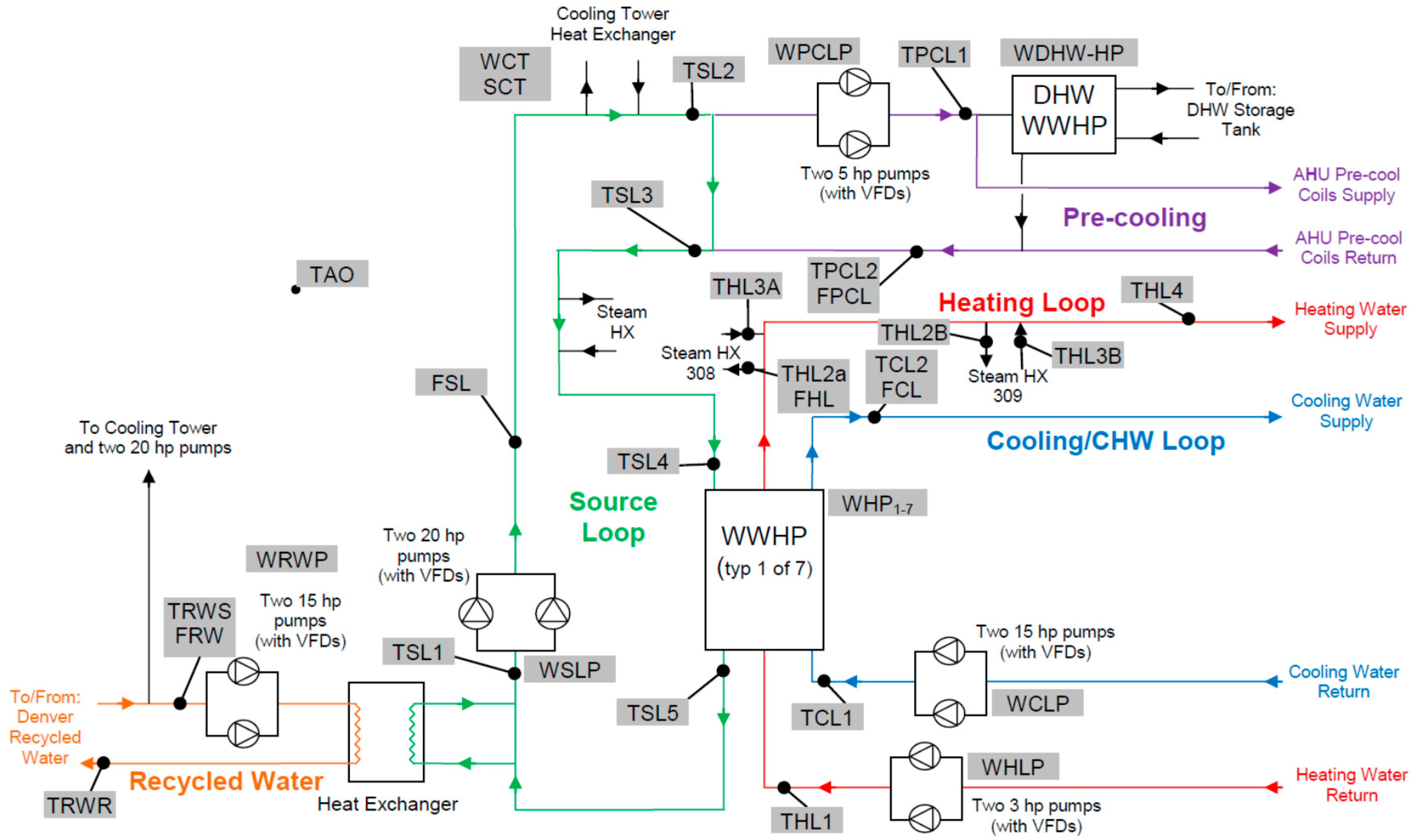

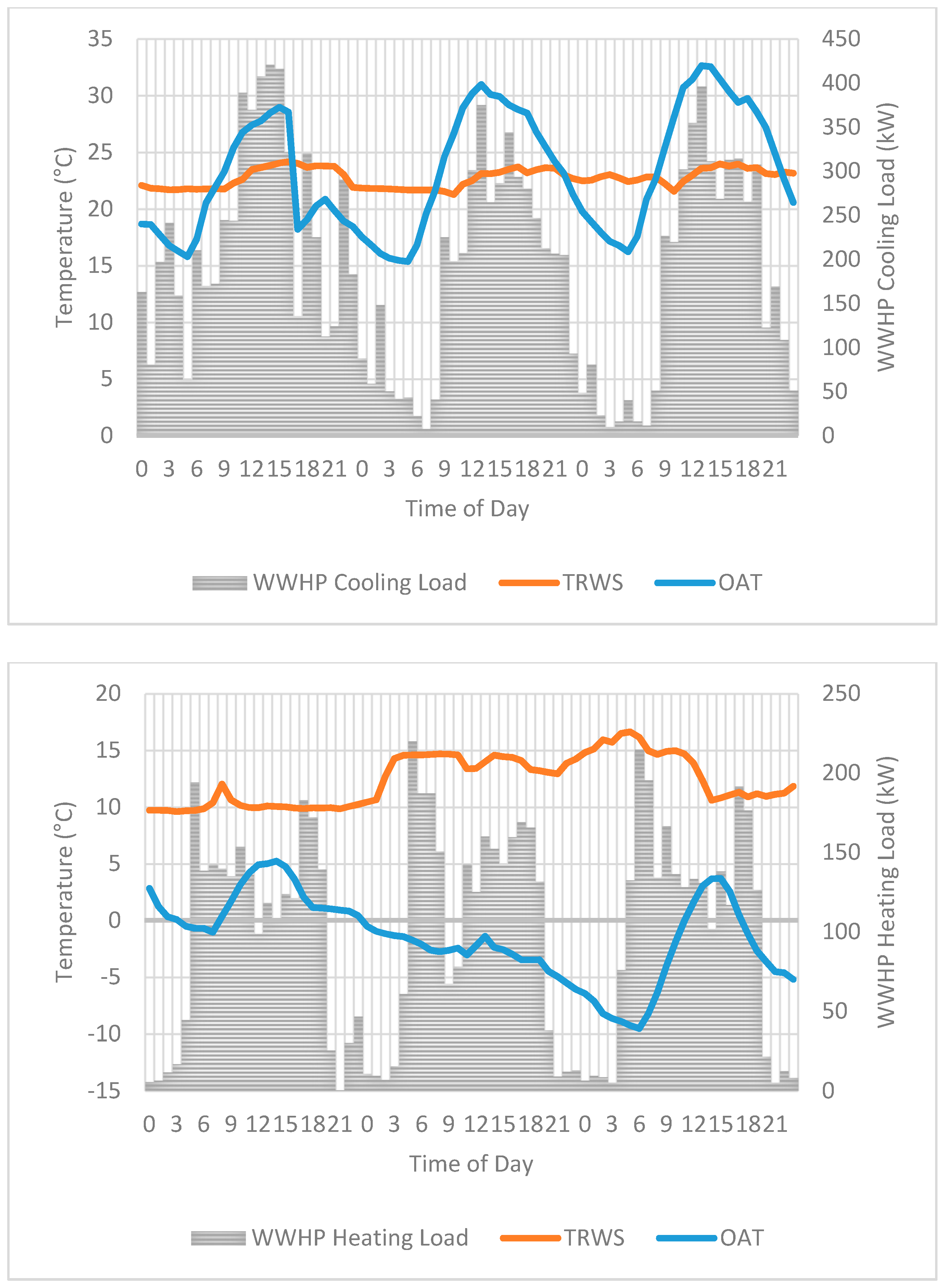
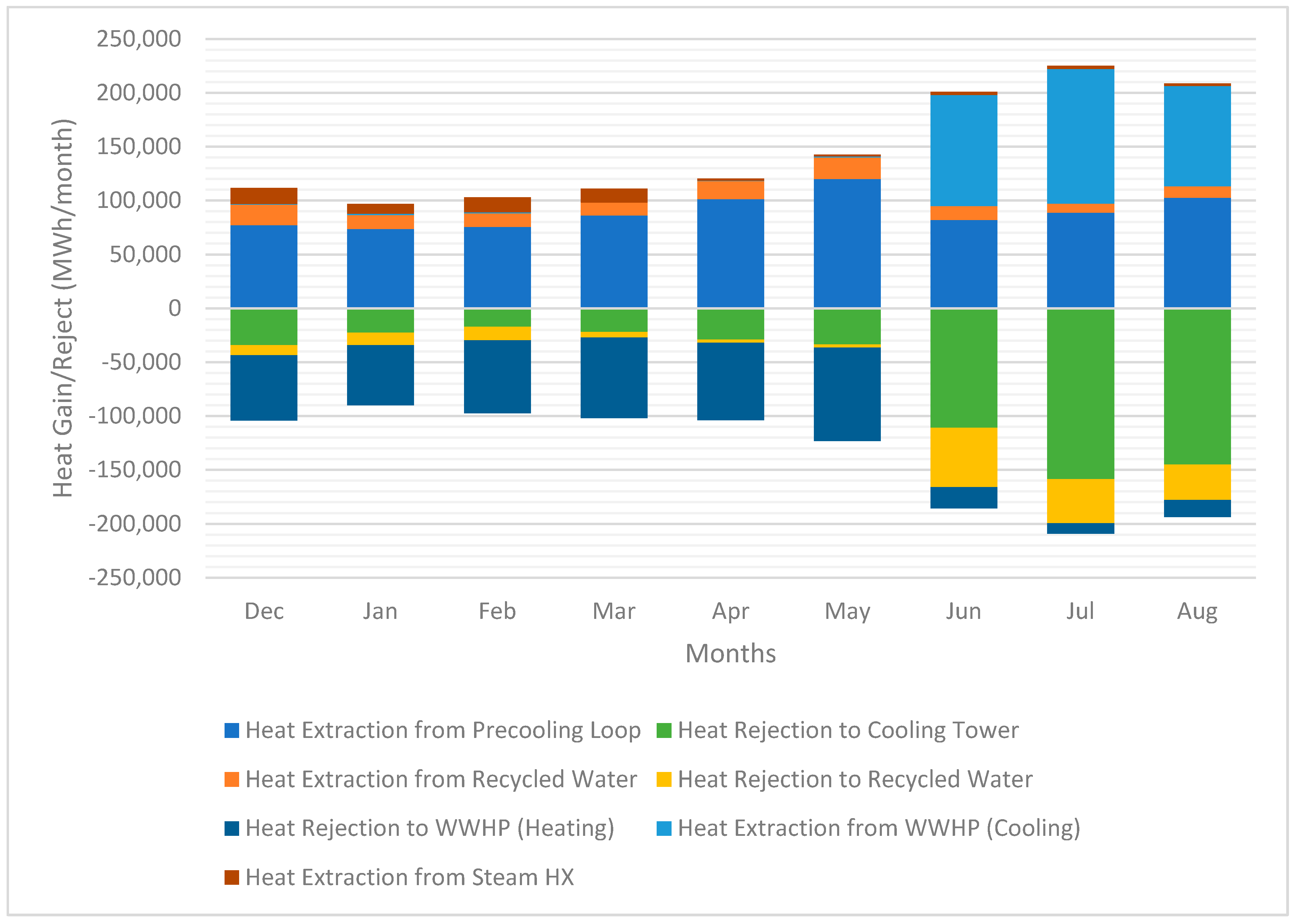
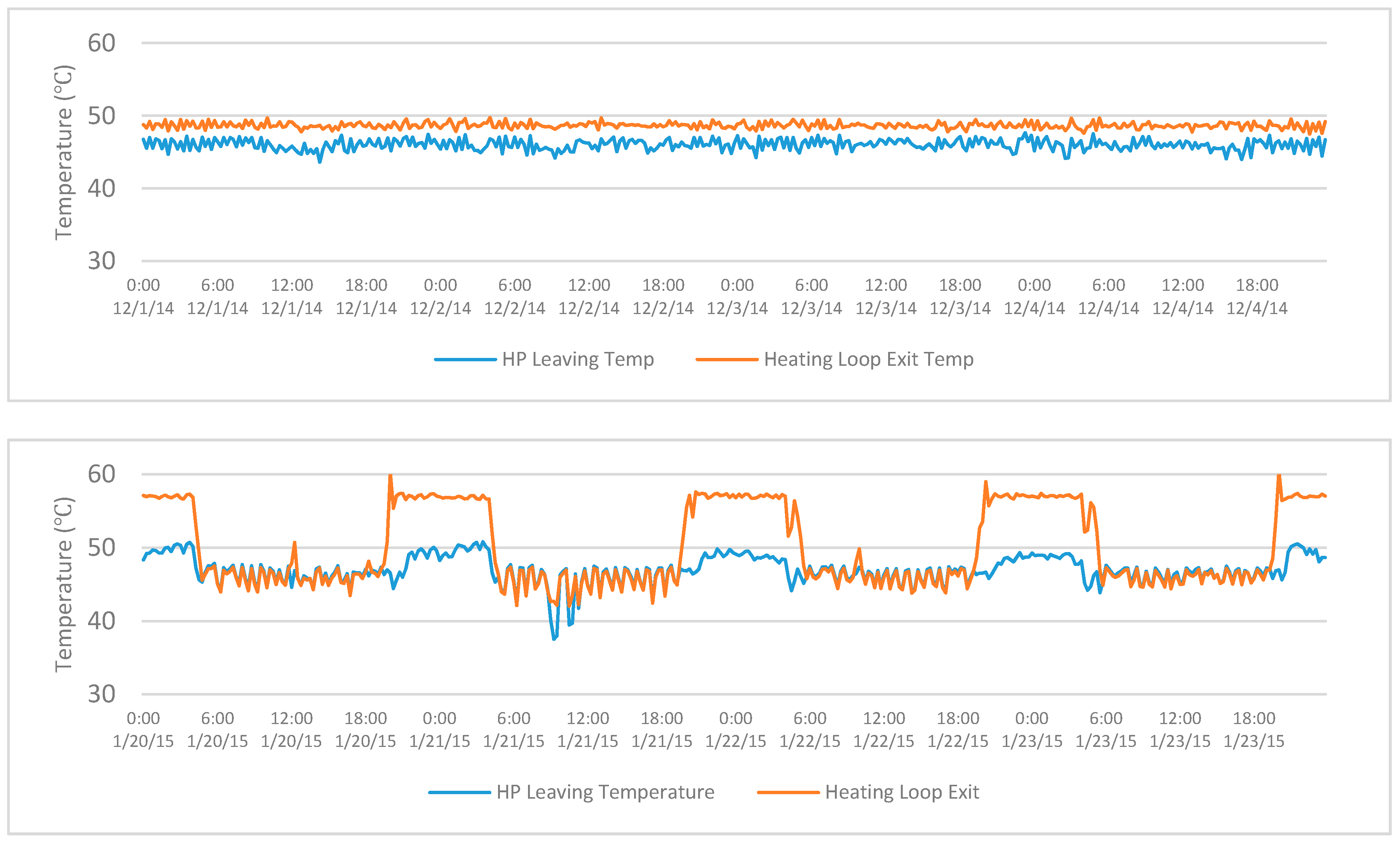
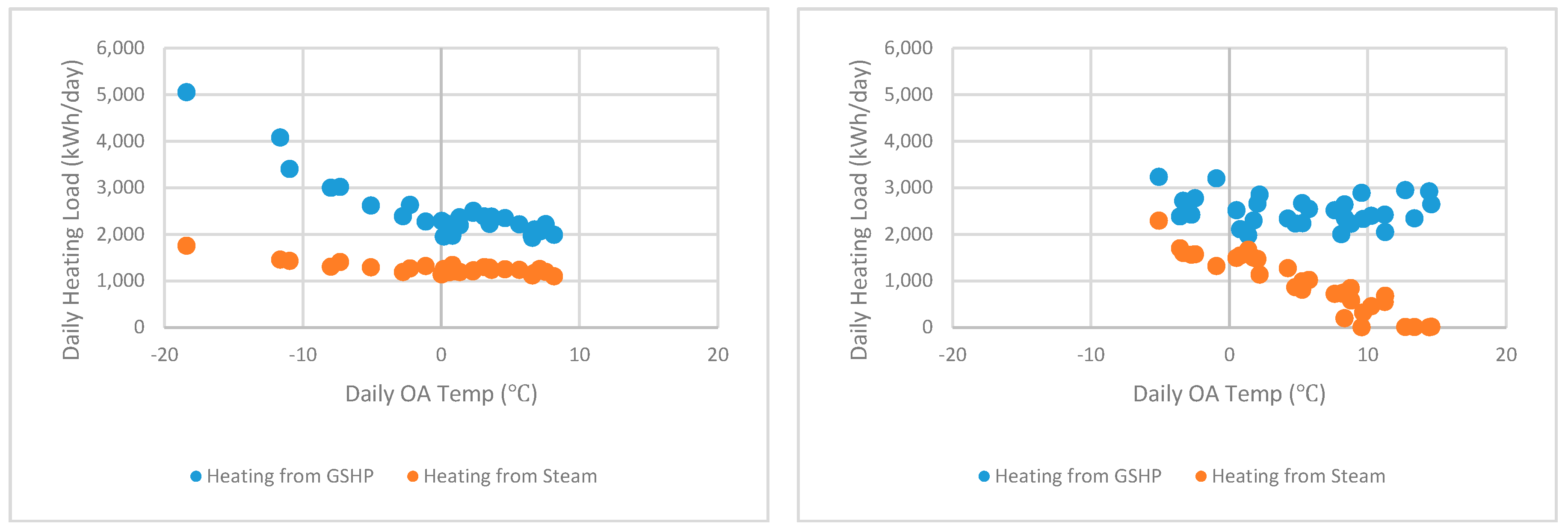
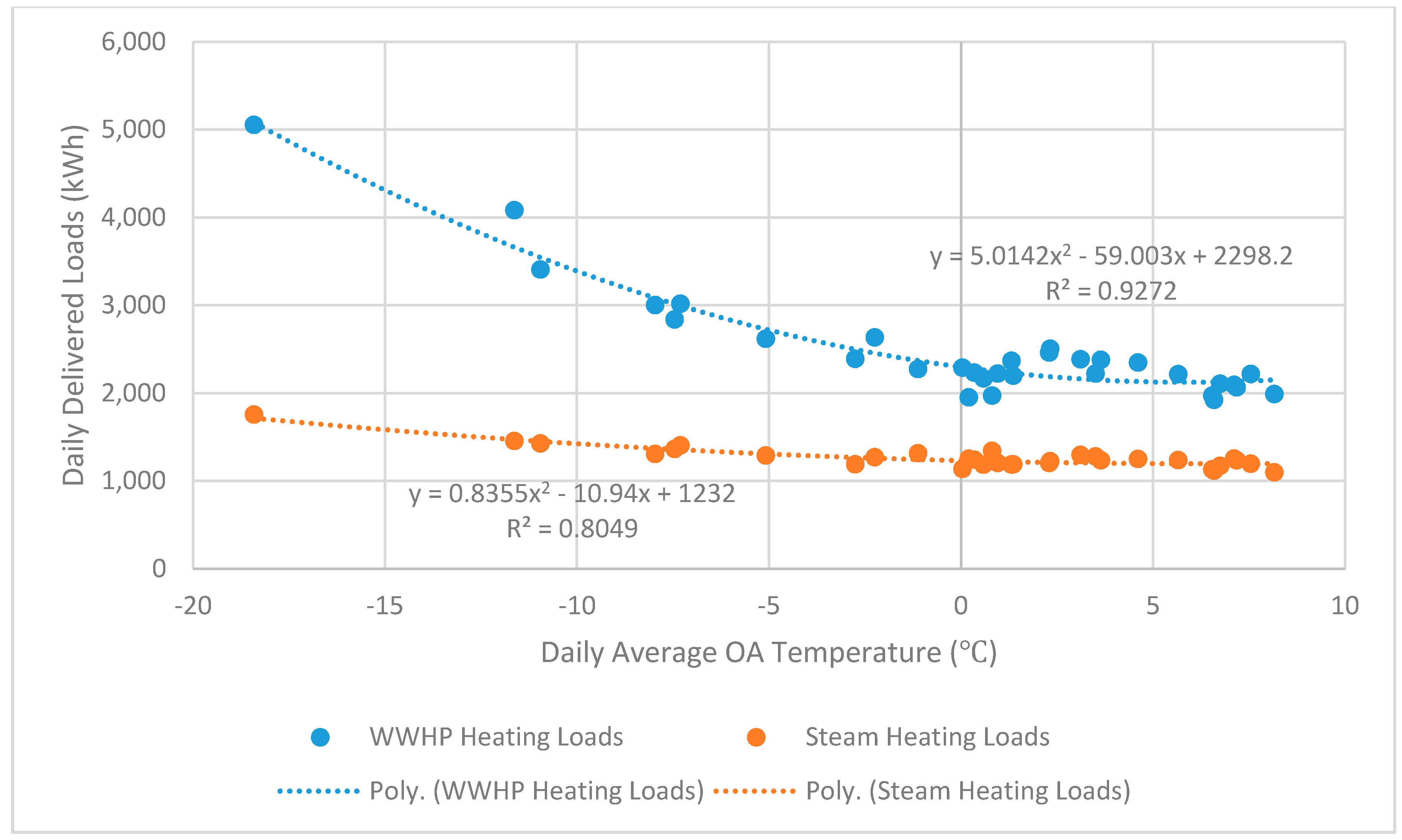

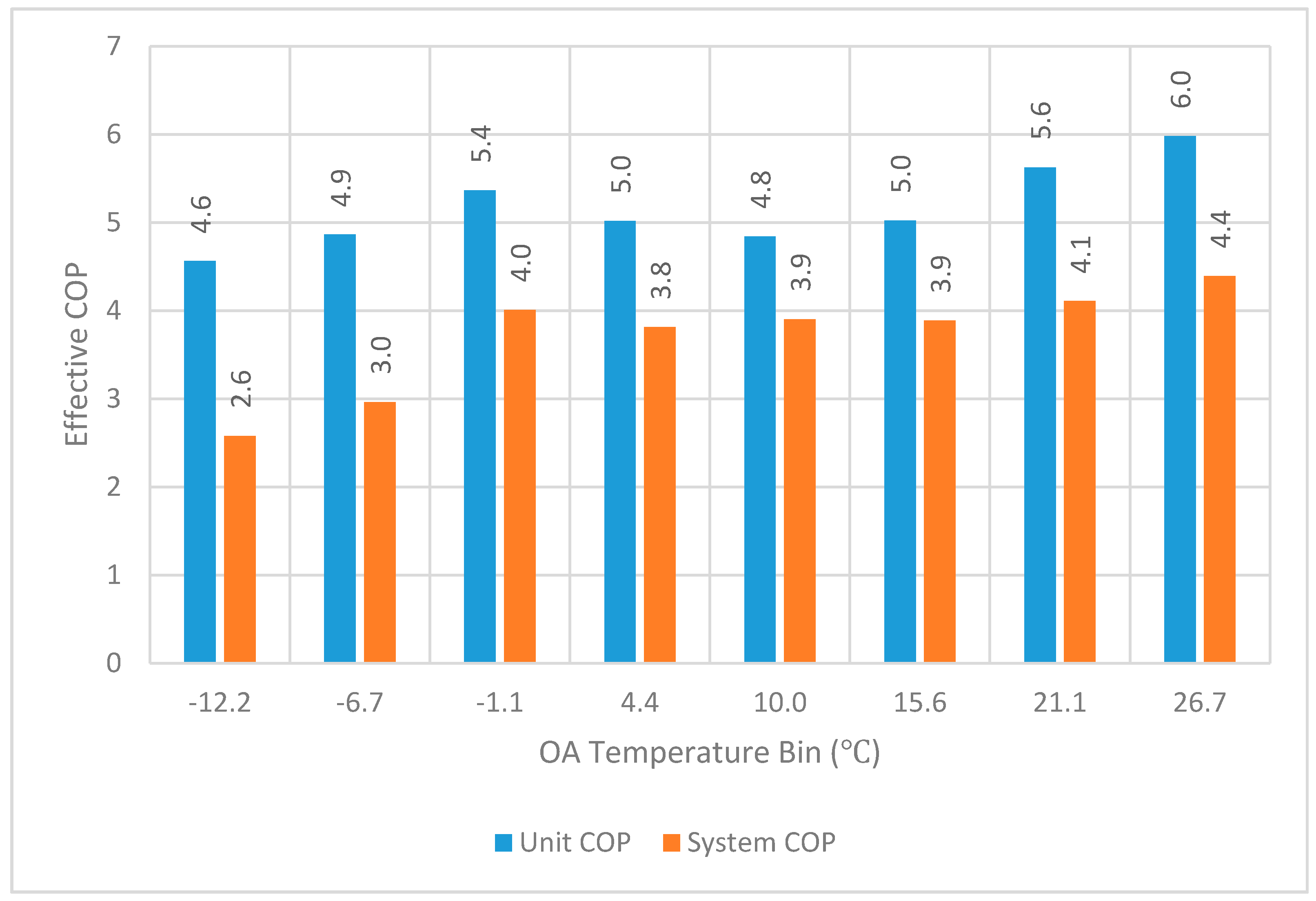
| Label | Description | Label | Description |
|---|---|---|---|
| TRWS | Recycled Water Supply Temperature | THL3b | HW Loop Temp after Steam HX 309 |
| TRWR | Recycled Water Return Temperature | FHL | HW Loop Flow |
| FRW | Recycled Water Flow | WHLP | HW Loop Pump Power |
| WRWP | Recycle Water Pumps Power | TCL1 | CHW Loop Temperature to WWHPs |
| TSL1 | Source Loop after RW HX Temperature | TCL2 | CHW Loop Temperature from WWHPs |
| TSL2 | Source Loop after Cooling Tower Temperature | FCL | CHW Loop Flow |
| TSL3 | Source Loop after Pre-cool Loop Temperature | WCLP | CHW Loop Pump Power |
| TSL4 | Source Loop after Steam HX Temperature | WDHW-HP | DHW WWHP Power |
| TSL5 | Source Loop after WWHP Temperature | TPCL1 | Pre-Cooling Loop Temperature prior to DHW WWHP |
| FSL | Source Loop Flow | TPCL2 | Pre-Cooling Loop Temperature after DHW WWHP |
| WSLP | Source Loop Pump Power | FPCL | Flow pre-Cooling Loop |
| WHP1-7 | Heat Pump Power (WWHPs 1 through 7) | WPCLP | Pre-Cooling Loop Pump Power |
| THL1 | HW Loop Temperature to WWHPs | WCT | Cooling Tower Power |
| THL2a | HW Loop Temp before Steam HX 308 | SCT | Cooling Tower On/Off Status |
| THL2b | HW Loop Temp before Steam HX 309 | TDHWHPS | DHW Heat Pump Supply Temp |
| THL3a | HW Loop Temp after Steam HX 308 | TAO | Ambient Temperature |
| Electricity (kWh) | Natural Gas (GJ) | Source Energy (GJ) | Electricity Cost ($) | Natural Gas Cost ($) | Total Cost ($) | |
|---|---|---|---|---|---|---|
| New Control | 21,734 | 166 | 421 | 1652 | 758 | 2410 |
| Old Control | 18,975 | 240 | 468 | 1442 | 1097 | 2539 |
| Savings | 47 | 130 | ||||
| Savings (%) | 10% | 5% |
| Baseline System | RWHP System | |||
|---|---|---|---|---|
| Electricity | Natural Gas | Electricity | Natural Gas | |
| Annual HVAC related site energy | 331,509 kWh | 4979 GJ | 334,419 kWh | 1017 GJ |
| Annual HVAC related source energy (GJ) | 8600 | 4302 | ||
| Source energy savings (GJ) | – | 4298 | ||
| % of source energy savings | – | 50.0% | ||
| Energy cost by fuel type ($) | $25,195 | $22,953 | $25,416 | $4692 |
| Total energy cost ($) | $48,148 | $30,108 | ||
| Recycled water use ($) | – | $2398 | ||
| Additional make-up water ($) | $654 | |||
| Annual cost savings ($) | – | $16,295 | ||
| % of cost savings | – | 33.8% | ||
| CO2 emissions (kg) by fuel type | 244,653 | 260,354 | 246,801 | 53,225 |
| Total CO2 emissions (kg) | 505,007 | 300,026 | ||
| CO2 emission reductions (kg) | – | 204,980 | ||
| % of CO2 emission reductions | – | 40.6% | ||
| Cost Item | RWHP System | Baseline System |
|---|---|---|
| HVAC equipment (AHUs) | $1,075,000 | $1,075,000 |
| Hydronic piping (to AHUs) | $146,000 | $146,000 |
| Air distribution system (duct work, etc.) and controls | $439,060 | $439,060 |
| Temperature control system | $330,000 | $330,000 |
| RWHP equipment (heat pumps, heat exchangers, circulation pumps, control system) | $288,747 | |
| Pipeline installation (recycled water main to the museum) | $1,100,000 | |
| RWHP equipment Installation | $624,045 | |
| Baseline water cooled chiller system (two 1050 kW chillers)1 | $360,000 | |
| Steam boiler plant (including construction of boiler room)2 | $1,370,000 | |
| Design, other professional cost, and indirect cost | $1,291,431 | $627,907 |
| Total | $5,294,283 | $4,347,967 |
| Cost premium | $946,316 | |
| Simple payback (years) | 58 | |
| Total (if the length of the recycled water pipeline branch is 305 m) | $4,527,616 | $4,347,967 |
| Cost premium | $179,649 | |
| Simple payback (years) | 11 |
© 2018 by the authors. Licensee MDPI, Basel, Switzerland. This article is an open access article distributed under the terms and conditions of the Creative Commons Attribution (CC BY) license (http://creativecommons.org/licenses/by/4.0/).
Share and Cite
Im, P.; Liu, X.; Henderson, H. Operational Performance Characterization of a Heat Pump System Utilizing Recycled Water as Heat Sink and Heat Source in a Cool and Dry Climate. Energies 2018, 11, 211. https://doi.org/10.3390/en11010211
Im P, Liu X, Henderson H. Operational Performance Characterization of a Heat Pump System Utilizing Recycled Water as Heat Sink and Heat Source in a Cool and Dry Climate. Energies. 2018; 11(1):211. https://doi.org/10.3390/en11010211
Chicago/Turabian StyleIm, Piljae, Xiaobing Liu, and Hugh Henderson. 2018. "Operational Performance Characterization of a Heat Pump System Utilizing Recycled Water as Heat Sink and Heat Source in a Cool and Dry Climate" Energies 11, no. 1: 211. https://doi.org/10.3390/en11010211




